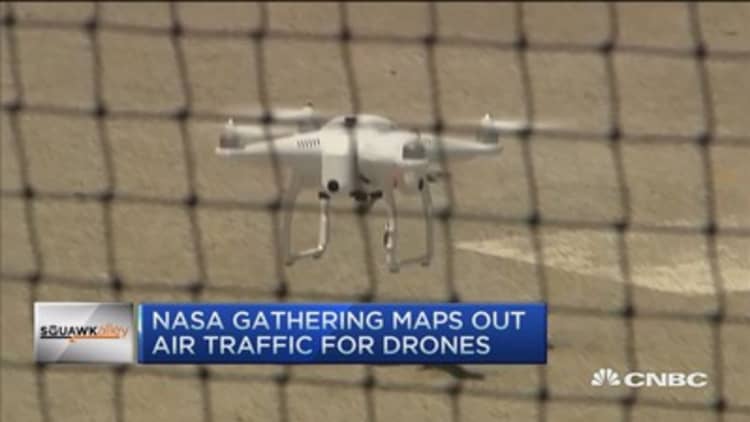
Drones could become an $82 billion industry in 10 years and employ 100,000 Americans, according to an industry group.
That assumes, of course, that the drone business can lift off. The public is concerned about drones spying on them, falling on them, or interfering with manned aircraft—as has been the case in California during recent wildfires.
Meantime, the FAA is developing rules to allow commercial drones to fly in domestic airspace, but the process is taking longer than many expected.
Read More Drone users told to fly safe after plane near miss
"We have a lot of real estate agents that are out there taking pictures of properties, and that's great, but we have much more complex operations that we need to be able to get to, including beyond visual line-of-sight and nighttime operations. ... We need rules for that," said Brian Wynne, president and CEO of the Association for Unmanned Vehicle Systems International.
Wynne said those other uses include drones for insurance companies, construction and agriculture. Currently, commercial drones in U.S. airspace are banned unless a company gets an FAA exemption.
Eight hundred exemptions have been issued, and Wynne said 20 "industry applications" are actually flying drones.
"Flying and regulating by exemption is not going to work," he said. "We need finalized rules as soon as possible."
This week at NASA's Ames Research Center in the heart of Silicon Valley, the space agency hosted a gathering of companies large and small to map an air traffic management system for unmanned aircraft. Companies presenting at the conference included Amazon, Google, Verizon and Cisco.
Read More Drones: The next big risk
"A lot of people will say, 'Well, Cisco is a networking company, what's the relevance to drones?'" said Helder Antunes of Cisco. "Well, drones have to be connected, networked. They transmit ungodly amounts of data."
Networking is exactly what Cisco does. Antunes sees opportunities for drones as part of the "Internet of Everything," including their potential help in transmitting data in remote areas.
"If you look at a situation where you have roadside connectivity, and you're in a rural setting, and you need to augment that connectivity, an unmanned vehicle or drone can be a perfect vehicle for that," he said. "But that vehicle has to be intelligent, and it has to have enough processing capabilities to basically report an emergency situation, report the traffic situation, not just report everything is OK constantly."
Read More Hackers can change high-tech gun's target: Report
Amazon presented a drone management proposal that would create a skyway with different "lanes" for different drones. Very simple drones would stay below 200 feet, more advanced ones—including, perhaps, those making Amazon deliveries—would fly at 200 to 400 feet, and there would be a "no-fly" zone between 400 and 500 feet.

The higher the drones fly, the greater the ability they would need for communicating with each other and with manned aircraft above. They'd also have to be equipped with collision-avoidance systems.
Amazon doesn't envision drones being managed the way air traffic controllers manage airplanes, because there will be far more drones than manned aircraft. Instead, several highly capable drones that are able to self-navigate and self-separate would be supervised by one controller.
Read MoreSam's Club takes a chance on drones this Christmas
"A paradigm shift in airspace management and operations is necessary to safely accommodate the one-operator-to-many-vehicle model required by large-scale commercial fleets," Amazon Prime Air project VP Gur Kimchi said.
Why NASA? "The first 'A' in NASA is aeronautics," said Parimal Kopardekar, who runs the Safe Autonomous System Operations Project for the agency. "NASA has been doing research on air traffic management for the last two decades."
All that said, it's the FAA that would ultimately regulate the industry. Kopardekar said the air traffic management system NASA envisions would create a safe environment. "Another way to look at this," he said, "is if you have self-driving cars, you still need lanes and stop signs to keep things flowing efficiently as well as (safely)."
Read More In 'Game of Drones,' the battle is real. Sorta
Jesse Kallman of Airware, which is building an operating system that can be used by different commercial drone companies, said the industry needs a framework for air traffic.
"What are we going to do when Amazon wants to deliver a package, when Verizon wants to inspect their network or inspect a tower, or first responders want to get into an area and deliver a defibrillator or something?" asked Kallman, whose company has raised more than $40 million from Andreessen Horowitz, Kleiner Perkins, Google Ventures, GE Ventures and others.
"Even something as mundane as what Amazon is trying to do with drones delivering packages to people, the last thing you want is these devices falling out of the sky on someone's head," said Cisco's Antunes. "So all of this is going to require connectivity, networking, security, and in essence it's going to require technologies that enable these devices to talk to each other."
But the industry has to overcome the idea of "drones gone wild," and find a way to allow private citizens to own and fly the unmanned craft without creating the kind of situation firefighters have seen in California.
"A lot of people are buying these small, low-cost consumer systems off the Internet and they don't really understand the aviation culture," Kallman said. "They don't really understand some of the challenges that they could actually pose to manned aircraft."


